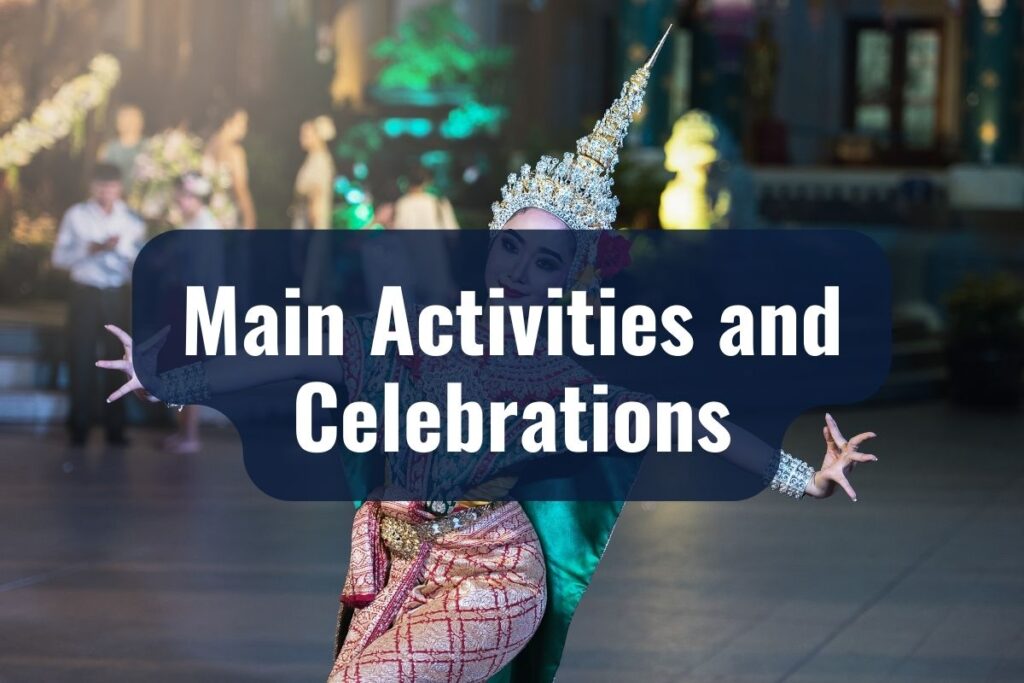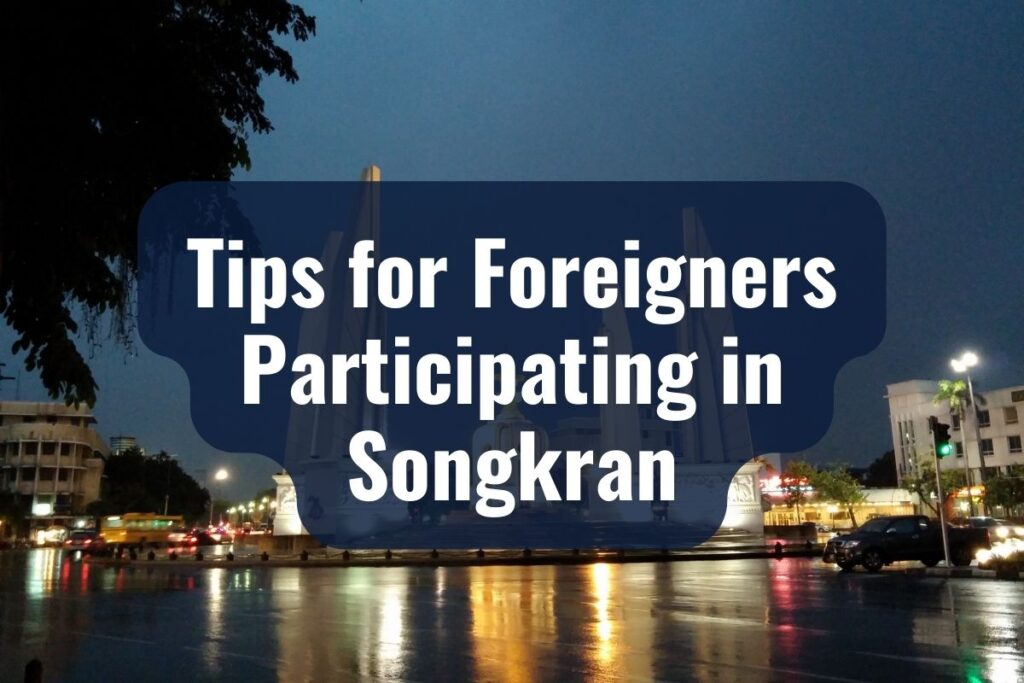The Songkran Festival, often called the “Thai New Year,” is one of Thailand’s most celebrated and revered occasions. Rooted in ancient traditions, this festival spans several days in the middle of April, marking the end of the dry season and the welcoming of the rainy season.
The vibrant streets, filled with joyous celebrations and water splashes, are juxtaposed with the serene temple rituals, painting a holistic picture of Thailand’s rich cultural tapestry during this special period.
KEY TAKEAWAYS
- Songkran Festival, Thailand’s New Year celebration, blends ancient traditions with contemporary festivities.
- Originating from Sanskrit’s “Sankranti,” Songkran has evolved, embracing both spiritual rituals and jubilant water fights.
- Water, symbolic of purification and life, plays a central role in the festival’s customs.
- Songkran offers a range of activities, from temple visits and merit-making to parades and water battles.
- For foreigners, respecting local customs while actively participating ensures a memorable experience.
- Adhering to a set of dos and don’ts helps foreigners navigate Songkran respectfully and enjoyably.
Significance of the Festival in Thai Culture
Songkran is more than just a festive occasion; it holds deep cultural and spiritual significance for the Thai people. It’s a time for cleansing, renewal, and merit-making. Families come together, pay respect to their elders, and remember their ancestors.
Origins and History
The term “Songkran” originates from the Sanskrit word “Sankranti,” which translates to “movement” or “change.” Historically, the festival marked the sun’s transition from one zodiac sign to another, specifically its move into Aries.
This astrological significance resonates with many cultures across Asia, and in Thailand, it heralded the New Year until 1940 when the date was officially changed to January 1st.
Songkran’s roots can be traced back to ancient Brahminic traditions, where the day was seen as the balance between the old and new years. It was a time of reflection, where people thanked the old year for its blessings and welcomed the new one with hope and optimism.
How It Has Evolved Over the Years
Over the centuries, Songkran has gracefully blended its ancient customs with newer practices. While its spiritual essence remains unaltered, the festival has adapted to changing times and societal norms.
For instance, the playful water splashing, now synonymous with Songkran, originally had a profound meaning. Water, used to cleanse Buddha images in temples, was considered blessed.
Collecting this water and pouring it gently over elders’ hands was seen as a token of respect and a way to transfer blessings. As time passed, this ritualistic pouring transitioned to jovial water fights, especially among the younger generations, leading to the exuberant street celebrations we witness today.
Another evolution can be seen in the regional differences that have emerged. Different parts of Thailand, from Chiang Mai in the north to Phuket in the south, have added their unique flavors and traditions to the Songkran celebrations, making it a diverse and inclusive festival that truly encapsulates the spirit of Thailand.
Cultural Significance

The Importance of Water During Songkran
Water holds a profound place in the Songkran festival, symbolizing purity, rejuvenation, and life. During Songkran, it serves as a metaphorical and literal tool for washing away the past year’s misfortunes, clearing the path for a fresh, promising start. This act of cleansing is not just limited to individuals but extends to homes, public spaces, and sacred Buddha images.
Traditional Rituals and Practices Associated with the Festival
At the heart of Songkran are rituals that underline the core values and beliefs of Thai culture:
Rod Nam Dam Hua: An age-old custom where younger members of the family pour fragrant water onto the hands of elders, seeking their blessings and expressing gratitude and respect. This gesture signifies a fresh start, strengthening familial ties.
Bathing of Buddha Images: Both in temples and homes, Thai people clean and pour water over Buddha statues. This ritual not only preserves and cleanses the sacred images but is also a way of earning merit, invoking prosperity, and showing reverence for the teachings of Buddha.
Building Sand Pagodas: On temple grounds, you might observe people creating pagodas out of sand. This practice compensates for the sand that’s carried away on the soles of devotees throughout the year. Decorated with colorful flags and flowers, these pagodas serve as a reminder of the impermanent nature of life.
Offering Alms: Early in the morning, Thai people make merit by offering food to Buddhist monks. It’s a serene and soulful experience, highlighting the nation’s deep-rooted spiritual ethos.
Main Activities and Celebrations

Traditional Activities
Temple Visits: The heart of Songkran remains rooted in spirituality. Devotees, dressed in pristine white, visit temples to pray, meditate, and participate in religious ceremonies. They seek blessings for the upcoming year and take part in merit-making activities, reflecting on their deeds and aspiring for a harmonious life ahead.
Merit-making: A key aspect of Songkran involves making merit, which is believed to cleanse one’s soul and pave the way for a prosperous future. This could involve donating to temples, releasing animals like fish or birds, and offering food to monks.
Sand Pagodas: As previously mentioned, creating sand pagodas at temples is a traditional practice, symbolizing the cyclical nature of life and the transient nature of worldly possessions.
Modern Festivities
Water Fights: Arguably the most iconic aspect of modern Songkran celebrations, water fights are held throughout Thailand. Streets transform into battlegrounds where locals and tourists alike, armed with water guns, buckets, and hoses, engage in gleeful water wars. While this may seem purely fun on the surface, it’s a modern interpretation of the festival’s cleansing theme.
Parades and Parties: Major cities in Thailand host grand parades showcasing traditional dances, vibrant floats, and elaborately dressed performers. These parades often culminate in public spaces where stages are set for musical performances, ensuring the festivities continue well into the night.
Beauty Pageants: “Miss Songkran” is a beauty contest held in various parts of Thailand. Adorned in traditional Thai attire, participants compete, symbolizing Thai culture’s grace and beauty.
Special Foods and Dishes Associated with Songkran
Food is an integral part of any celebration, and Songkran is no exception. Here are a few dishes that are especially popular during this festival:
Khao Chae: A refreshing rice dish served in cold jasmine-scented water, accompanied by a variety of side dishes.
Pad Thai: While enjoyed year-round, this stir-fried noodle dish finds a special place in the Songkran feast.
Kanom Jeen: Rice noodles served with a variety of curries, it’s a favorite among the locals during this festive season.
Tips for Foreigners Participating in Songkran

Dress Appropriately
While Songkran is all about getting wet and having fun, it’s crucial to respect the local customs with your attire:
- Opt for light, quick-drying clothes that can handle multiple water splashes.
- Traditional patterns or styles are appreciated, but ensure they are not too revealing.
- Consider wearing sunglasses to protect your eyes from water and waterproof sunscreen to shield against the tropical sun.
Safety Precautions
With water everywhere, it’s better to be safe than sorry.
- Always keep your valuables in waterproof bags. Mobile phones, wallets, and cameras are best kept inside zip-lock bags or specialized waterproof pouches.
- Be cautious of water pressure. While most participants are gentle, some water guns can have strong sprays.
- Streets can get slippery. Opt for non-slip footwear like sandals or water shoes.
Respecting Local Customs
While the festival is filled with jubilance, always be mindful of local traditions:
- Avoid splashing monks or the elderly. They hold a revered place in Thai culture, and it’s best to show respect.
- Many locals observe a moment of prayer or reverence before indulging in festivities. It’s courteous to wait or move aside during such moments.
Recommended Places to Join the Festivities
To truly soak in the Songkran experience, consider visiting:
Chiang Mai: Renowned for its massive parades and traditional celebrations, it’s a hub for both locals and foreigners during Songkran.
Bangkok: The capital city never disappoints with its grand celebrations, especially around areas like Khao San Road and Silom.
Phuket and Pattaya: For beach lovers, these cities offer a unique blend of beach parties and Songkran festivities.
Dos and Don’ts

Navigating Songkran can be a delightful experience, provided one remains mindful of certain etiquettes. Here’s a succinct guide to help foreigners respect and enjoy the festival to the fullest:
| Dos | Don’ts |
| Participate actively in the festivities | Splash water after sunset |
| Ask before splashing someone | Use ice-cold water |
| Show respect to Buddha images | Wear overly revealing clothes |
| Use clean water for splashing | Disrupt religious ceremonies |
| Smile and enjoy the moment | Drink and drive |
Dos:
Do Participate Actively: Thai people appreciate when foreigners engage wholeheartedly in their customs. Join the water splashing, visit temples, and taste the festive delicacies.
Do Ask Before Splashing: While it’s a festival of water, it’s polite to gauge if someone is ready to be splashed, especially if they appear to be avoiding the water.
Do Show Respect to Buddha Images: When visiting temples, always approach Buddha images with respect. Avoid loud conversations and maintain a reverent posture.
Do Use Clean Water: If you’re participating in the water splashing, ensure the water is clean. This promotes a safe and enjoyable experience for all.
Do Smile and Enjoy: Songkran is a joyous occasion. A smile goes a long way in fostering goodwill and creating memorable interactions.
Don’ts:
Don’t Splash After Sunset: Typically, water-throwing stops after sunset. It’s essential to adhere to this custom out of respect.
Don’t Use Ice-cold Water: While the temptation might be there due to the heat, using ice-cold water can be uncomfortable and potentially harmful to others.
Don’t Wear Revealing Clothes: While it’s warm and you’ll get wet, wearing overly revealing clothes can be deemed disrespectful in this cultural context.
Don’t Disrupt Religious Ceremonies: If you come across a religious ceremony or prayer, maintain a respectful distance and avoid interrupting the proceedings.
Don’t Drink and Drive: Songkran parties might involve alcohol but always prioritize safety. If you plan on consuming alcohol, ensure you have safe transportation back.
Songkran, with its myriad of vibrant festivities and deep-seated traditions, offers a window into the soul of Thailand. It’s an occasion that weaves together the threads of fun, family, faith, and renewal, creating a tapestry that is as radiant as the Thai spirit itself.
For foreigners, participating in Songkran is a rare opportunity to immerse oneself in a cultural experience that transcends boundaries. It allows one to not only be a spectator but a celebrant, embracing the ethos of joy, reverence, and community that Songkran so beautifully epitomizes.
As the streets of Thailand come alive with the melodies of laughter, the rhythm of water splashes, and the harmony of prayers, one realizes that Songkran is more than a festival. It’s a celebration of life, love, and the timeless spirit of Thailand. Embrace it with an open heart, and you’ll carry its essence with you, long after the festivities have concluded.


